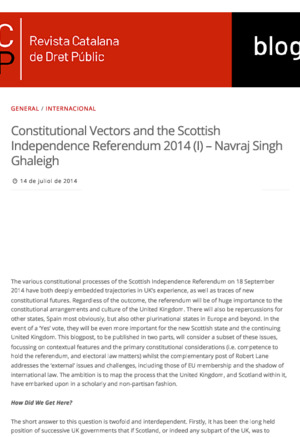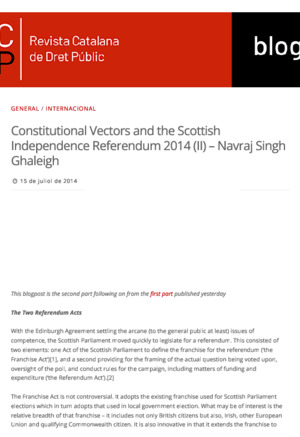The Emperor in the Japanese Constitution
Tipo de documento
Otros
Resum
This blogpost is a review of the communication “El emperador en la Constitución japonesa” read at the seminar “Japón: la posición del Emperador y el principio de igualdad en la Constitución” held at the Faculty of Law of the University of Barcelona on March 18 2014. The present Japanese Constitution was established in 1947, after World War II and was intended to replace Japan’s previous militaristic and absolute monarchy system with a form of liberal democracy. This Constitution has various characteristics. First of all, the Japanese Constitution provides for a parliamentary system and guarantees certain fundamental rights. Second, the Japanese Constitution, also known as “Peace Constitution”, is most characteristic and famous for the renunciation of the right to wage war contained in Article 9. Third, it states the sovereignty of the people and the Emperor of Japan is “the symbol of the State and of the unity of the people” and exercises a purely ceremonial role without the possession of sovereignty.ISSN
2696-8916
Nota
Inclou apèndix en anglès i castellà: "The Japanese Constitution of 1947"
Citación recomendada
Naito, Mitsuhiro. (28 de juliol de 2014). The Emperor in the Japanese Constitution. RCDP Blog. https://hdl.handle.net/20.500.14227/4693
Autor/a
Lengua
Inglés
Castellano
Publicado por
Escola d’Administració Pública de Catalunya
Fecha de publicación
2014-07-28Extensión
8 p.
Publicado en
RCDP blog
Materias (CDU)
00 - Ciencia y conocimiento. Investigación. Cultura. Humanidades
070 - Periódicos. Prensa. Periodismo. Ciencias de la información
342 - Derecho constitucional. Derecho administrativo
94 - Historia general y por países
Materias (LEMAC)
Palabras clave
Documentos relacionados
Apunt de blog disponible a:
Enlace al documento relacionado
Documentos para descargar
Este ítem aparece en la(s) siguiente(s) colección(ones)
- RCDP blog [586]
Derechos
Excepto si se señala otra cosa, la licencia del ítem se describe como http://creativecommons.org/licenses/by/4.0/
Ítems relacionados
Mostrando ítems relacionados por Título y Materia.
-
Elecciones en Kenia: de etnocracia a democracia
Franceschi, Luis G. (RCDP blog, 2013-03-12)Inclou seccions sobre: El origen del estado africano; Kenia nace; El drama de las elecciones en el 2007; Un nuevo proyecto constitucional; 2012-2013: Un período de nuevas alianzas; Una paz admirable -
Constitutional Vectors and the Scottish Independence Referendum 2014 (I)
Ghaleigh, Navraj Singh (RCDP blog, 2014-07-14)The various constitutional processes of the Scottish Independence Referendum on 18 September 2014 have both deeply embedded trajectories in UK’s experience, as well as traces of new constitutional ... -
Constitutional Vectors and the Scottish Independence Referendum 2014 (II)
Ghaleigh, Navraj Singh (RCDP blog, 2014-07-15)With the Edinburgh Agreement settling the arcane (to the general public at least) issues of competence, the Scottish Parliament moved quickly to legislate for a referendum. This consisted of two elements: ...





